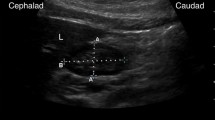Abstract
Purpose: The purpose of the study was to evaluate the impact of a clinical pathway on the volume of imaging studies performed in children with suspected clinical diagnosis of hypertrophic pyloric stenosis. The pathway suggested referral to surgeons for clinical evaluation for palpation of the olive prior to ordering imaging studies. Only those children in whom the olive could not be palpated would be referred for imaging, and it was anticipated that imaging volume would be reduced following guideline implementation. Materials and methods: The database of the Health Policy and Clinical Effectiveness Department was used to evaluate all patients who had surgery for hypertrophic pyloric stenosis. The presence of a palpable olive and the type of imaging were evaluated both prior to and after the implementation of the clinical guideline. Results: Prior to the guideline, 85 infants had surgery for pyloric stenosis, with 83 of the 85 (97%) having imaging. After the implementation of the guideline, 90 infants had surgery for pyloric stenosis with 84 of 90 patients imaged (92%). A chi-square analysis demonstrated no significant difference in the percentage of children imaged in the two groups (P=0.104). Approximately one in five children referred for vomiting were diagnosed with hypertrophic pyloric stenosis. Conclusion: No significant change in imaging volume occurred following initiation of a guideline which recommended clinical evaluation for palpation of the olive prior to ordering imaging studies. Multiple factors probably contributed to the lack of demonstrated changes.
Similar content being viewed by others
References
Hernanz-Schulman M (2003) Infantile hypertrophic pyloric stenosis. Radiology 227:319–331
Hernanz-Schulman M, Sells LL, Ambrosino MM, et al (1994) Hypertrophic pyloric stenosis in the infant without a palpable olive: accuracy of sonographic diagnosis. Radiology 193:771–776
Schlesinger AE, Parker BR (2004) Acquired gastric and duodenal disorders. In: Kuhn JP, Slovis TL, Haller JO (eds) Caffey’s pediatric diagnostic imaging. Mosby, Philadephia, pp 1593–1615
Teele RL, Smith EH (1977) Ultrasound in the diagnosis of idiopathic hypertrophic pyloric stenosis. N Engl J Med 296:1149–1150
O’Keeffe FN, Stansberry SD, Swischuk LE, et al (1991) Antropyloric muscle thickness at US in infants: what is normal? Radiology 178:827–830
Carver RA, Okorie M, Steiner GM, et al (1987) Infantile hypertrophic pyloric stenosis—diagnosis from the pyloric muscle index. Clin Radiol 38:625–627
Davies RP, Linke RJ, Robinson RG, et al (1992) Sonographic diagnosis of infantile hypertrophic pyloric stenosis. J Ultrasound Med 11:603–605
Blumhagen JD (1986) The role of ultrasonography in the evaluation of vomiting in infants. Pediatr Radiol 16:267–270
Cohen HL, Zinn HL, Haller JO, et al (1998) Ultrasonography of pylorospasm: findings may simulate hypertrophic pyloric stenosis. J Ultrasound Med 17:705–711
Mandell GA, Wolfson PJ, Adkins ES, et al (1999) Cost-effective imaging approach to the nonbilious vomiting infant. Pediatrics 103(6 Pt 1):1198–1202
Senquiz AL (1991) Use of decubitus position for finding the “olive” of pyloric stenosis. Pediatrics 87:266
Forman HP, Leonidas JC, Kronfeld GD (1990) A rational approach to the diagnosis of hypertrophic pyloric stenosis: do the results match the claims? J Pediatr Surg 25:262–266
Macdessi J, Oates RK (1993) Clinical diagnosis of pyloric stenosis: a declining art. BMJ 306:553–555
Poon TS, Zhang AL, Cartmill, T, et al (1996) Changing patterns of diagnosis and treatment of infantile hypertrophic pyloric stenosis: a clinical audit of 303 patients. J Pediatr Surg 31:1611–1615
Shuman FI, Darling DB, Fisher JH (1967) The radiographic diagnosis of congenital hypertrophic pyloric stenosis. J Pediatr 71:70–74
Michalsky MP, Pratt D, Caniano DA, et al (2002) Streamlining the care of patients with hypertrophic pyloric stenosis: application of a clinical pathway. J Pediatr Surg 37:1072–1075
Author information
Authors and Affiliations
Corresponding author
Rights and permissions
About this article
Cite this article
Helton, K.J., Strife, J.L., Warner, B.W. et al. The impact of a clinical guideline on imaging children with hypertrophic pyloric stenosis. Pediatr Radiol 34, 733–736 (2004). https://doi.org/10.1007/s00247-004-1255-z
Received:
Revised:
Accepted:
Published:
Issue Date:
DOI: https://doi.org/10.1007/s00247-004-1255-z




